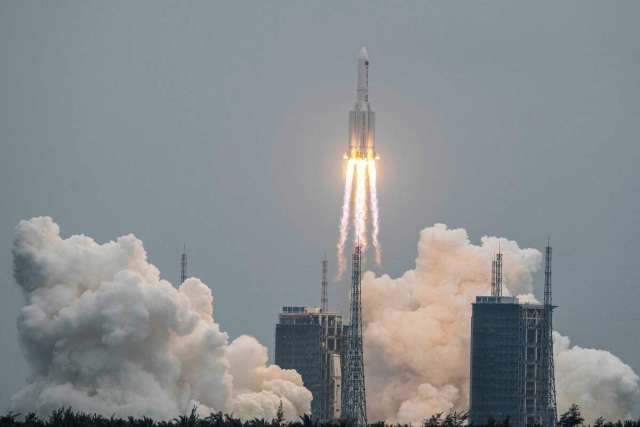Although the probability that fragments of a space rocket will "return" to Earth, injure or kill someone is small, and most of them are likely to fall into the ocean or somewhere safe, the researchers warn that the risks increase over time.
There is a ten percent chance that the debris of a rocket launched into space will fall to Earth after its uncontrolled entry into the atmosphere, a study by scientists from the University of British Columbia (Vancouver, Canada), published in the journal Nature Astronomy, has shown.
According to the authors of the work, in 2020, after at least 60% of launches into low-Earth orbit, rocket hulls remained there for several days, months or even years, eventually posing a risk of collision with satellites, falling and death of people on the ground, at sea and in airplanes. For a long time, this was not given importance, but there are more and more space launches, as well as space debris.
There is no need to go far for examples: in May 2020, the 18-ton main stage of the Chinese Changzheng-5B rocket uncontrollably entered the dense layers of the atmosphere of our planet after launching a prototype of a new generation manned spacecraft into orbit. The wreckage of the hull fell on two villages in West Africa, damaging several buildings. A year later, in the spring of 2021, Beijing launched the heavy Changzheng-5: it successfully brought the first module of the new Chinese space station Tiangong to LEO. Fragments fell into the Indian Ocean, although most of them burned down.
According to scientists, these two stages were the heaviest objects that uncontrollably returned to our planet — since the Soviet station " Salyut-7 " in 1991, when it entered the Earth's atmosphere at a speed of over 30 thousand kilometers. Of course, in the case of the Chinese launches, the United States was quick to immediately blame The Celestial Empire.
"But there is no international consensus on an acceptable level of risk, and other space powers, including the United States, are making a similar choice regarding uncontrolled re—entry into the atmosphere," the researchers noted, recalling 2016, when a SpaceX rocket entered the atmosphere over the territory of Indonesia.
In the United States, standard methods of preventing the formation of orbital debris ( ODMSP ) are applied to space launches: the risk of accidents from a rocket entering the atmosphere should be below the threshold value of 1 to 10,000 (nevertheless, scientists call it meaningless in an era when it is possible to create reusable carriers). And sometimes they turn a blind eye to the demands. Thus, the US Air Force abandoned ODMSP in 37 launches of 66 conducted on their order from 2011 to 2018. The argument was that it was too expensive to replace missiles that did not comply with the rules. NASA, in turn, neglected the requirements seven times from 2008 to 2018, including during the launch of Atlas V in 2015, when the risk of accidents was estimated at 1 in 600.
"The consequences of the launch depend on the media model. Some have "boosters" that are dumped suborbitally and usually into the ocean. <...> If the main stage reaches orbit, it is either left there (as in the case of Changzheng-5B), or returned back controllably. When the stage is removed with a sufficiently low perigee, the gas resistance gradually reduces its height and eventually leads to uncontrolled re-entry into the atmosphere, which can occur at any point of the flight path. On the contrary, with a controlled entry into the atmosphere from orbit, an engine is used to direct the stage to a remote area of the ocean or another safe zone," the article says.
The authors used publicly available data on population density, reports on rocket launches, orbital inclination and space debris over 30 years to calculate the approximate number of victims due to falling debris of this kind. From May 1992 to May 5, 2022, more than one and a half thousand man-made objects descended from orbit: more than 70% of them did it uncontrollably. Re-entry into the atmosphere was considered unmanageable if the time interval between the launch and re-entry dates exceeded a week.
Scientists focused on fragments of carriers that remain partially intact and pose a danger to people. Calculations have shown that if, as a result of each uncontrolled entry into the atmosphere, debris is scattered over an area of ten square meters, one or more related accidents will occur within the next decade with a probability of 10% — directly on the ground, at sea or in a flying plane.
Jakarta and Dhaka — the capitals and largest cities of Indonesia and Bangladesh, respectively — as well as Lagos, the sea gate of Nigeria, were in a special risk zone. The chances that rocket debris would fall on their residents were three times higher than for New York, Beijing and Moscow. However, as the authors of the study note, both estimates are conservative, since the number of launches is growing rapidly.
Since there are already technologies for re—entry and at the same time controlled descent, the only thing we lack is the collective will to use such developments because of the costs associated with them. "Recent advances in technology and mission design make most uncontrolled re-entry into the atmosphere unnecessary, but the states and companies conducting launches do not want to doom themselves to costs. Therefore, governments whose populations are at risk should demand that major space powers act together by authorizing guided rocket re—entry into the atmosphere, and non-compliance with the requirements should have significant consequences," the scientists concluded.

